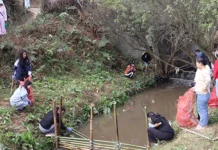[ Dr Sailajananda Saikia & Dipak Sharma ]
The agricultural landscape of Arunachal Pradesh is changing as a result of organic agriculture. The hypothesis of this article is that the sector would experience sustained growth by utilising traditional methods and government initiatives to explore the possibilities and constraints of organic agriculture in Arunachal. Our objective is to present a thorough study of the state’s trajectory towards a sustainable agricultural future by looking at the situation of organic farming now, the factors propelling market expansion, logistical and infrastructure issues, and potential future plans.
Biodiversity as a foundation
The unique topography and temperature of Arunachal make it the perfect place for organic farming. The state’s distinctive mix of plains, valleys, and mountains creates a variety of soil types and microclimates that are perfect for growing a wide range of crops, including fruits, vegetables, spices, cereals, and pulses. In addition to increasing the state’s ability to produce organic food, this natural richness serves as a living test bed for climate-resilient farming methods.
Specific crop advantages in different regions include:
– Lower altitudes (below 1,000m): Ideal for rice, maize, millet, and oilseeds
– Mid-altitudes (1,000-2,000m): Suitable for temperate fruits like kiwi, apple, and pear
– Higher altitudes (above 2,000m): Perfect for high-value medicinal plants and herbs
An ‘organic by default’ culture
In the past, Arunachal has grown more than 80% of its crops without the use of agrochemicals or chemical fertilisers. The local culture is firmly rooted in traditional practices, including terrace farming and jhum cultivation, often known as shifting cultivation. While terrace farming helps decrease soil erosion and conserves water, which is a vital resource in mountainous terrains, jhum agriculture involves seasonal clearing and is managed using centuries-old ecological expertise. These actions demonstrate a deep dedication to sustainability and offer a solid basis for the organic movement in the state.
These natural resources serve as both the foundation for the production of organic food and a real-world illustration of climate-resilient farming methods.
Because of traditional methods like terrace farming and jhum (shifting) cultivation, more than 80% of Arunachal’s crops are traditionally farmed without the use of artificial pesticides or fertilisers. These techniques, which are rooted in millennia of ecological wisdom, reduce soil erosion and preserve essential water supplies. Growing customer demand for wholesome, chemical-free food has also contributed to the rise in popularity of organic produce in both urban and local markets.
Increasing health consciousness among consumers, reflected in the national trend towards organic foods, bolsters the organic market. According to the USDA Organic Market Report-2021, the Indian organic food market is expected to grow significantly, with the Northeast region playing a crucial role in this growth. This aligns perfectly with Arunachal’s organic movement and modern health and wellness priorities.
Economic growth backed by government initiatives
Rapid urbanisation and rising disposable incomes have provided the economic impetus for the region’s organic market. The state government has played a pivotal role by launching ambitious initiatives, notably the Mission Organic Value Chain Development for the North East Region (MOVCD-NER). This initiative offers financial assistance of Rs 46,500 per hectare, including specific support for organic inputs, and has expanded organic farming across 8,500 hectares. Complementary schemes have already benefited over 5,000 farmers, fostering steady growth in the sector.
The state government’s commitment to achieving 100% organic production has led to a 20% increase in organic farming area between 2017 and 2022, bolstering consumer confidence and farmer participation.
Furthermore, niche products such as dried kiwi, prized for their high mineral, fibre, and vitamin content, underscore the export potential. Recent reports from the APEDA indicate a 50% increase in organic exports from the Northeast region between 2018 and 2022, positioning Arunachal as a competitive player in the international market.
Overcoming infrastructure and logistical challenges
Despite these promising developments, the state grapples with critical challenges that could impede further progress:
– Storage and processing: Limited cold storage facilities and underdeveloped processing infrastructure result in post-harvest losses that can reach up to 30%. Without modern storage and transportation systems, organic produce risks quality degradation before reaching markets.
– Transportation and accessibility: Many farming areas are remote, with poor road connectivity exacerbating transportation challenges. This not only inflates costs but also disrupts market access, necessitating urgent investment in transportation networks.
Drawing inspiration from successful models in neighbouring regions like Sikkim – where investments in refrigerated transport and collection centres significantly reduced losses – Arunachal is exploring similar infrastructure enhancements.
The role of cooperative models and capacity building
To mitigate high input costs and boost economic viability, cooperative farming models and community-based initiatives are gaining traction. By sharing resources and leveraging bulk purchasing, these models have led to notable income increases among cooperative members and lower input costs.
Training programmes by various institutions have further equipped farmers with essential skills:
– ICAR-NOFRI training programmes: Focus on organic vegetables and spices cultivation.
– Himalayan University skill orientation programme: Provides practical training on organic and integrated farming systems.
– Krishi Vigyan Kendras (KVK): Conduct regular training sessions for farmers and rural youths.
These programmes have collectively trained over 4,500 farmers in organic vegetable and spice cultivation, integrated farming, and quality seed production.
Strategic directions for sustainable growth
As Arunachal continues its journey towards a fully organic agricultural sector, the synergy of traditional knowledge, robust government support, and modern infrastructural investments emerges as the defining force behind its transformation. The state’s unique biodiversity, combined with an ‘organic by default’ethos, has laid a firm foundation for sustainable growth.
Addressing the challenges of storage, transportation, and economic inputs through innovative solutions and collaborative models can propel the region to new heights in both domestic and international organic food markets. The state’s commitment to organic farming, evidenced by the 20% increase in organic farming area between 2017 and 2022, and the 50% increase in organic exports from the Northeast region between 2018 and 2022, underscores the potential for future growth.
This synthesis of traditional practices with progressive government initiatives reinforces the promise of organic agriculture – ushering in a new era of sustainability, economic progress, and environmental stewardship in Arunachal. As the state addresses its challenges and capitalises on its natural advantages, it is poised to become a leading organic agriculture hub, contributing significantly to India’s organic food market growth and setting an example for sustainable farming practices worldwide. (Dr Sailajananda Saikia is Professor, Department of Agriculture, RGU, Rono Hills.)



